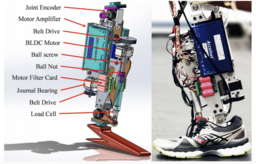Unified Lower-Limb Prosthetic Control Strategy
TECHNOLOGY NUMBER: 2020-423

OVERVIEW
A single, unified prosthesis controller that captures the entire gait cycle through virtual constraints- Eliminates the need to divide the gait into different periods with independent controllers
- Reduces the number of control parameters that must be tuned for each new patient
BACKGROUND
Powered prosthetic legs are employed in an effort to optimize the usefulness of orthoses for patients following amputation. Several control methods have been proposed for facilitating these devices, but almost all of them divide the gait cycle into multiple, sequential periods with different controllers. In one common approach, a machine switches between joint impedance controllers based on the period of gait, though a more complex approach using a combination of finite state machines with taskspecific impedance controllers may be utilized. The latter approach requires substantial tuning of control parameters and switching rules for each period and task, potentially requiring several hours to configure a powered knee-ankle prosthesis for a single amputee patient. When perturbed, this control approach could switch to the wrong state and use the wrong controller, which may increase an amputee’s risk of falling. Given that humans move in a smooth, continuous manner over a periodic gait cycle, a need exists for a reactive controller that accounts for normal characteristics of biped ambulation, and which unifies the gait cycle and provides stability.
INNOVATION
Researchers have devised a novel control strategy for an above-knee powered prosthetic leg that unifies the entire gait cycle, therefore eliminating the need to switch between controllers during different phases of the gait cycle. The new device provides an improvement over existing control methods which divide the gait cycle into several sequential periods with independent controllers that vary by patient-specific control parameters and require tuning by clinicians. This single controller reduces the number of control parameters needing to be tuned for each patient, thereby reducing the clinical time and effort required for fitting a powered prosthesis for each lower-limb amputee. An additional advantage of a unified controller includes its potential favorable impact on exoskeletons and autonomous bipedal robots. This advancement permits exact characterization of the desired actuated joint motion over the entire gait cycle from a single output function.
A reduced-order Discrete Fourier Transformation (DFT) is used to define virtual constraints that continuously parameterize periodic joint patterns as functions of a mechanical phasing variable. The feasibility of the controller has been demonstrated using simulations of an amputee walking model, showing that a single, unified controller can accommodate a range of human walking speeds. Future device iterations will attempt to demonstrate clinical viability by allowing clinicians to visually modify trajectories while configuring the control system for different amputee subjects.